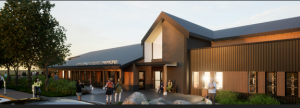Officials from Walas, an urban design company founded in the Netherlands, showed off some of the fascinating projects coming out of Europe during Buildex Vancouver, focusing on one of their recent projects deep in South Holland.
Carbon6 is located in Heerlen, Holland, an area that has faced decades of economic decline in its traditional industries of coal mining and chemicals. But where many saw stagnation, Walas saw opportunity.
When one of the city’s largest employers, the National Statistics Office, decided to move to a new centre the company formulated a plan to revitalize the vacant buildings and sites.
Walas now owns and operates a 500,000-square-foot complex, fully re-purposed for arts and culture, start-up companies and social enterprises. A total of 1,200 people are currently employed in the building. The site, formerly a mining area until the 1970s, is also on its way to being carbon neutral.
"It made an amazing transition from this grey industry into green," said Dirk van der Ven, COO of Walas Europe.
"We developed it not from a traditional real estate way but from a people’s perspective. We call this concept ‘eco growth.’"
This also meant turning weakness into strength. For example, Walas harnessed the geothermal power of the site’s old mining shafts to store the building’s heat.
But some solutions aren’t so close by. When Walas set out to build a wood car park facility, they quickly found that the Netherlands and surrounding countries didn’t have any suitable materials that wouldn’t need a coating or epoxy. The team finally settled on a wood from West Africa.
But what really sold them was the system of reduced impact logging used to harvest it. Rather than clear cutting an area, trees are taken in a calculated way to ensure a sustainably supply.
"The forest has time to regenerate itself," said van der Ven.
Walas was also impressed by how the wood supplier built a factory to cut and ship the wood to create local jobs.
More impressive than the wood car park facility is what goes on top of it. Later this year Walas plans to finish an 84,000-square-foot solar project on top of the 800-space parking lot. The €2.2 million project is expected to make back the money in four years by generating 36 per cent of the building’s energy.
The quick return on investment, noted van der Ven, is mostly due to the incredibly high energy costs in the city. Walas is also mandating that participating companies must use apprentices.
Van der Ven said the team is also constructing a wetland. The idea came up after noticing nearby trains that brake while going through the city stir up a great deal of dust that falls on the solar panels. When it rains the dust would be washed into the sewage system.
"We didn’t want that to happen," he said.
Now the carpark collects the water and feeds it into a constructed wetland that includes plants, grass and a complex root system that naturally filters contamination.
"We get cleaner water than what rained down from the sky," he said.
The water is then used to fill the building’s fountain, clean building windows and wash cars parked under the solar panels.
The parking facility will also offer charging stations for electric cars and bikes, a car sharing program and incentives to use public transportation.
Gerben Van Straaten, global CEO of Walas, explained that the decisions made regarding Carbon6 reflect what the company believes about cities, where more and more people are moving.
"We really believe that we have to think about the world of tomorrow," Van Straaten said.
"The battle of sustainability will be won or lost in cities. If we continue our current lifestyles, by 2035, we would need two earths to keep up with our global demand for goods, food and materials."
He noted that the construction industry, which produces a massive amount of the waste and C02, has a responsibility to sustainability.
The Carbon6 complex is now home to the largest creative cluster in Holland, including the region’s largest pop music school and artists in painting, glassworks and digital media.
The community has developed many successful initiatives, including the Treats gifts, which helps community members expand their business through curated gift packages.
The Dutch National Mining Museum, also located at Carbon6, honours the history of the region. The museum is located in an 1897 mineshaft building, classified as one of UNESCO’s top-100 monuments.










Recent Comments
comments for this post are closed